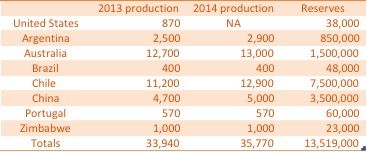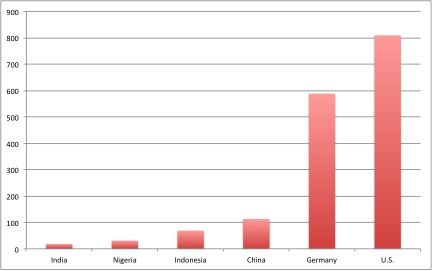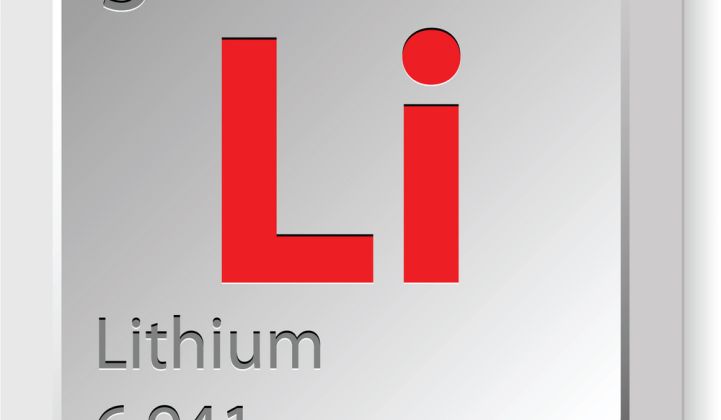Lithium-ion batteries are the default choice for most personal electronics and most electric cars today because they have a higher energy density than other technologies. The lithium-ion battery revolution began in earnest in the early 1990s after Sony and several other companies released the first commercial version of the new battery technology. Now that lithium-ion batteries are the predominant choice for many applications, particularly electric vehicles, questions about the global supply of lithium are timely. In short, can lithium-ion batteries scale up with increased demand?
With over a million electric vehicles (EVs) expected to be on the road globally by the end of 2015 and an increasing number of jurisdictions around the world focusing seriously on the growth of EV sales, we can expect strong growth in lithium-ion battery demand. Costs have come down steadily since the early 1990s. A recent peer-reviewed analysis found that lithium-ion battery prices have come down about 14 percent per year since 2007 and the long-term trend is also quite clear, in a standard learning curve effect, of 6 percent to 9 percent reduction in price for every doubling of production volume.
With Tesla continuing to grab headlines, let’s take a look at the lithium-ion battery growth trends through the lens of Tesla’s expected growth and see whether we can extrapolate from that to the global picture.
Tesla is expecting to produce 500,000 cars per year by 2020. With an assumed average capacity of 65 kilowatt-hours per vehicle (taking into account both the smaller battery of the expected Model S and the larger batteries like those in the P85 and P85D), 500,000 65-kilowatt-hour batteries per year would require, at about 10 kilograms of lithium per battery, 5 million kilograms (5,000 metric tons) of refined lithium per year.
Tesla is also planning to produce batteries like the Powerwall, recently announced, and much larger grid support batteries, as well as sales to third parties. Tesla’s expected lithium demand per year by 2020, at full production, is about 8,000 metric tons.
In an act of wild speculation, let’s suggest that the world will see 100 Tesla-size battery production factories by 2040 (or hopefully much sooner). This is enough to produce about 100 million EVs per year, plus a ton of stationary storage (global sales of cars are about 80 million per year, so 100 million a year seems about right when we’re including many years of sales in the future, with a larger global population). If this is the case, and the basic battery requirements don’t change too much, the world would need about 800,000 metric tons of lithium by 2040. And that’s just for battery production and doesn’t include the many other uses of lithium.
The U.S. Geological Survey produced a reserves estimate of lithium in early 2015, concluding that the world has enough known reserves for about 365 years of current global production of about 37,000 tons per year (Figure 1). Current production goes to a little over one-third for ceramics, almost one-third for batteries, and miscellaneous uses for the last one-third. The same report finds about 39.5 million metric tons of “resources,” which is a less firm category than “reserves.” "Resources" include supplies that could feasibly be extracted economically at some point in the future, whereas reserves estimates refer to current economic viability.
Even though 365 years of reserve supply sounds very comforting, the point of the EV and stationary storage revolutions is that current demand will shoot up, way up, if these revolutions do happen. The 100 Gigafactories scenario could come true. And if that happens, the 365-year supply would be less than a 17-year supply (13.5 million tons of reserves divided by 800,000 = 16.9 years).
Figure 1: USGS Mining and Reserves Data (Metric Tons)

Can lithium batteries scale up? According to this quick and purely speculative math, the short answer is, with current reserves, not just no, but hell no. With known lithium “resources” at 39.5 million tons, we get about 50 years of supply with 100 Gigafactories, which is a bit more comforting, but still not exactly a viable long-term solution.
The next question is how likely it is that the world’s reserves and resources will increase dramatically.
Peak lithium?
We can reasonably expect that lithium reserves and resources will increase as market demand grows. But as with all finite resources, we can expect to reach a peak in production at some point. I’ve written about the peak oil debate fairly extensively, so it is only fair and rational to apply a similar analytical lens to lithium production.
The lithium production market is still a fairly new market, so even though USGS and others have made some reserve and resource estimates already, it is premature to make any firm conclusions about future resource discovery and production. We’ve learned at least one lesson from the peak oil debate: higher prices do indeed spur innovation and increased production, at least they have in the U.S. Interestingly, almost the entire increase in global oil production has come from an increase in U.S. oil production. That is, the rest of the world has barely managed to stay in place on the treadmill of oil production, even in the face of far higher oil prices.
Even though the fracking revolution has not yet extended beyond the U.S., and may never do so, even the remarkable increase in U.S. production of oil in the last five years has left most peak oilers eating a healthy portion of crow pie. They may well win the debate before long, but for now, the cornucopians are winning.
With respect to the notion of peak lithium, there is a substantial difference between this commodity and oil because there are many ready substitutes for lithium that can be used in the manufacture of batteries. The USGS report cited above states: “Substitution for lithium compounds is possible in batteries, ceramics, greases, and manufactured glass. Examples are calcium and aluminum soaps as substitutes for stearates in greases; calcium, magnesium, mercury, and zinc as anode material in primary batteries; and sodic and potassic fluxes in ceramics and glass manufacture.” These substitutes may all face similar resource constraints as lithium, but there is a fundamental difference between changing battery chemistries and finding substitutes for oil more generally.
The entire world can’t run on cars
Even this little sketch of the issue highlights the obvious conclusion: we need to do our best to get away from single passenger cars -- even EVs -- and rely more on smart city design, walking, biking, carpooling, trains, shuttles, etc.
The elephant(s) in the room in this debate are China and India and the rest of the developing world. China’s population of 1.3 billion already has about half the number of cars as the U.S., despite the fact that it's far less economically developed, due to its population being four times that of the U.S. India has even lower rates of car ownership than China and a population almost as large. Figure 2 shows the stark disparity in car ownership per capita (“car” does not include motorcycles or other two-wheelers).
Figure 2: Car Ownership per Capita (per 1,000 people)

Source: Wikipedia compilation of various data sets
What happens when China and India and the rest of the developing world push en masse for personal car ownership and all the privileges that this brings? Well, the world definitely can’t handle that transformation under today’s fossil-fuel system, and it very likely can’t handle it under an EV-focused alternative system either, due to the resource constraints discussed above. We need to think hard about alternatives to passenger cars even while we recognize that EVs are far better than petroleum internal-combustion engine vehicles. We face a real conundrum as the developing world races to become more like the developed world.
There is nevertheless room for some long-term optimism when we look at the degree to which populations are declining in more than half of the world’s countries today. But, again, there is as much bad news mixed with the good, because many developing nations will continue to grow in population for some decades, a time during which economic growth and car ownership will very likely skyrocket unless we hit real resource constraints first.
Investing in lithium production?
This piece is not focused on the investment implications of lithium supplies, but I have previously suggested that investing in the LIT exchange-traded fund (ETF) is a good way to invest in the EV market in general. The expectation is that as lithium-ion battery demand rises, so will lithium demand. The commodity price for battery-grade lithium rose from $5,180 a metric ton in 2010 to $6,800 a ton in 2013, falling back a little to $6,600 in 2014. As with all commodities, however, the price of the commodity is a function of both demand and supply.
The LIT price has remained fairly stable in the last couple of years, even as EV sales and the price of lithium itself have grown strongly, so it’s not the case that LIT will automatically rise with growing EV sales. What is clear is that for investors looking to own a piece of the EV market, LIT is one option for doing so. And the degree to which LIT rises substantially will be a reflection of how well global production of lithium keeps up with demand. We can expect pinch points at times, so we may well see some peaks and troughs in LIT as the global EV market heats up.
An analysis by Motley Fool’s Maxx Chatsko looks at whether there is enough lithium supply to meet Tesla’s Gigafactory demand by 2020 and concludes that it’s unlikely that there will be enough increase in supply in the next few years to even support Tesla’s single factory, let alone the many, many other factories like it that will have to be built to meet demand if the EV revolution really gets underway in the next decade or two.
But while the Motley Fool analysis suggests that the next few years might be good for LIT and other lithium investors, they simply assume that there will be enough lithium resource to meet future demand, based on the USGS figures for known reserves. This is a different question than the short-term analysis, to be sure, and as we’ve seen, it looks like we probably will face a major challenge in scaling up lithium supplies to meet EV demand -- if the EV and stationary storage revolutions take off.
***
Tam Hunt is a lawyer and writer, owner of the renewable energy consulting company Community Renewable Solutions LLC, and author of the upcoming book The Solar Singularity: Why Our Energy Future Is So Bright.
Want access to ongoing data and research spanning the battery supply chain? Learn about Wood Mackenzie's Battery Raw Material Service here.




